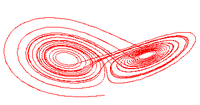Lorenz attractor
|
|
Lorenz_system_r28_s10_b2-6666.png
The Lorenz attractor, introduced by Edward Lorenz in 1963, is a non-linear three-dimensional deterministic dynamical system derived from the simplified equations of convection rolls arising in the dynamical equations of the atmosphere. For a certain set of parameters the system exhibits chaotic behavior and displays what is today called a strange attractor; this was proven by W. Tucker in 2001. The strange attractor in this case is a fractal of Hausdorff dimension between 2 and 3. Grassberger (1983) has estimated the Hausfdorff dimension to be 2.06 ± 0.01 and the correlation dimension to be 2.05 ± 0.01.
The system arises in lasers, dynamos, and specific waterwheels[1] (http://www.zeuscat.com/andrew/chaos/lorenz.html).
- <math>\frac{dx}{dt} = \sigma (y - x)<math>
- <math>\frac{dy}{dt} = x (r - z) - y<math>
- <math>\frac{dz}{dt} = xy - b z<math>
where <math>\sigma<math> is called the Prandtl number and r is called the Reynolds number. <math>\sigma,r,b>0<math>, but usually <math>\sigma=10<math>, <math>b=8/3<math> and r is varied. The system exhibits chaotic behavior for r = 28 but displays knotted periodic orbits for other values of r. For example, with r = 99.96 it becomes a T(3,2) torus knot.
See also
References
- Template:Journal reference
- Template:Journal reference
- Template:Book reference
- Jonas Bergman, Knots in the Lorentz system, Undergraduate thesis, Uppsala University 2004.
- Template:Journal reference (LINK) (http://adsabs.harvard.edu/cgi-bin/nph-bib_query?bibcode=1983PhyD....9..189G&db_key=PHY)
External links
- Lorentz Attractor (http://mathworld.wolfram.com/LorenzAttractor.html)
- Plot of the Lorenz attractor (http://home4.inet.tele.dk/filip/chaos/lorenz_attractor01.gif)
- planetmath.org: Lorenz Equation (http://planetmath.org/encyclopedia/LorenzEquation.html)
- Levitated.net: computational art and design (http://www.levitated.net/daily/levLorenzAttractor.html)de:Lorenz-Attraktor

